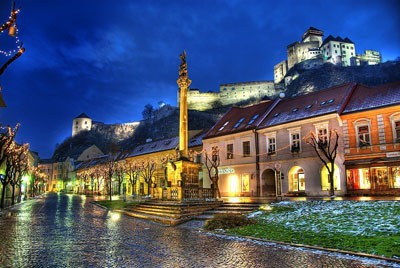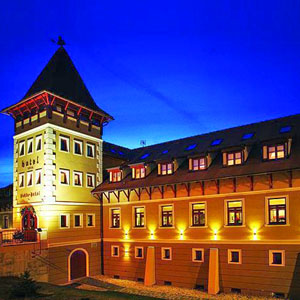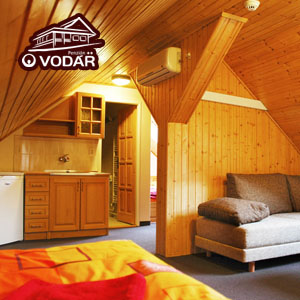Trenčín
Geography
 Trenčín is a city in western Slovakia of the central Váh River valley near the Czech border, around 120 km from Bratislava. It has a population of more than 56,000, which makes it the ninth largest municipality of the country and is the seat of the Trenčín Region and the Trenčín District. It has a medieval castle, standing on a rock above the city.
Trenčín is a city in western Slovakia of the central Váh River valley near the Czech border, around 120 km from Bratislava. It has a population of more than 56,000, which makes it the ninth largest municipality of the country and is the seat of the Trenčín Region and the Trenčín District. It has a medieval castle, standing on a rock above the city.
The City of Trenčín, Slovakia is in the center of the Považie region. It is the administrative center of the Trenčín Regional Government Unit, which consists of 9 Districts:
Bánovce nad Bebravou, Ilava, Myjava, Nové Mesto nad Váhom, Partizánske, Považská Bystrica, Prievidza, Púchov and Trenčín.
Thanks to its advantageous location, Trenčín is an important commercial, economic, cultural and sport center. It is also known as the “City of fashion“. Numerous institutions and companies have their headquarters and branches located in Trenčín. Expositions and fairs also have a long lasting tradition in Trenčín.
History
The site of Trenčín has been inhabited since time immemorial. Trenčín Castle, a typical medieval fortified castle is situated high on a rock above the city. Trenčín is best known for a Roman inscription on the rock below the Trenčín Castle dating from 179 AD, the era of the Marcomannic Wars, a series of wars between the Roman Empire and the Germanic Quadi. It denotes the site as Laugaricio and is the most northern evidence of the presence of Roman soldiers in central Europe.
It is plausible that Trenčín Castle was founded during the Great Moravian era. By the end of the 11th century it had become the administrative centre of Trenčín county. As one of the few stone castles in the Kingdom of Hungary it resisted the disastrous invasion of Mongols in 1241. In 1263 Trenčín was in the possession of Jakab Cseszneky royal swordbearer, but in 1302 King Wenceslas I took it away from the Cseszneky brothers because they were supporting his rival Charles Robert, and donated it to Matthew Csák. Between 1302 and 1321 the castle was the seat of the powerful magnate Matthew Csák who controlled most of what is now present-day Slovakia. Challenging the authority of king Charles Robert, Matthew Csák maintained a large court and pursued his own foreign policy. The Treaty of Trentschin betweeen Bohemia, Hungary, and Poland was signed in the city in 1335.
Trenčín gained a number of privileges during the Middle Ages: In 1324 the inhabitants were freed from paying tolls and the city received free royal town privileges in 1412 from King Sigismund. However during the following decades and centuries there were catastrophes and wars which lasted until the end of the 18th century. During the conflict between the Habsburgs and the supporters of the rival king, János Szapolyai, the town was captured in 1528 by imperial troops. In the 17th century the Ottomans were another threat from the south but they failed to conquer the city. The town then suffered from the Kuruc uprising against the Habsburgs and on 3 August 1708 the Battle of Trenčín took place close to the city. Two years later a plague killed 1,600 inhabitants of the city. Finally, in 1790 the town, along with the castle, was burned down and the castle has been in ruins ever since.
In the 19th century Trenčín flourished, as the railways to Žilina and Bratislava were built and many new enterprises were established, particularly in the textile, food and machine industries, and the town became the hub of the middle Považie (Váh) region. In 1867 Trenčín was downgraded from a "free royal town" to a "town with municipal government" and came under the direct control of the chief of Trenčín county. Trenčín flourished again during the era of the first Czechoslovak republic and became the capital of the Trenčín county again between 1940-1945 when the puppet Slovak Republic was in existence. Shortly after the Slovak National Uprising began, Trenčín was occupied by Nazi Germany and it became the headquarters of the Sicherheitsdienst and the Gestapo and a prison camp was placed there. Trenčín was captured by the Soviet troops on 10 April 1945.
Since 1990, the historical centre of the city has been largely restored and since 1996 it has been the seat of Trenčín Region and Trenčín District.
Tourism and Sights
The city is dominated by Trenčín Castle, which is the third-largest castle in Slovakia. Trenčín Castle is divided into upper and lower sections, with extensive fortifications. The upper castle has several palace buildings which surround the central medieval tower, which remains the highest point of the city. Below the castle, on the hillside, is the old parish church and a small upper square which is reached by historic covered stairs as well as by winding side streets. The old town has a large main square, with a large baroque church and a variety of shops, as well as a town tower.
Pohoda, the most visited music festival in Slovakia, has been organized in Trenčín since 1997. As of 2008, it takes place at the Trenčín Airport.
Reserve your accommodation in Trencin, where you can find cosy and luxurious hotels offering conference rooms for rent, but also guesthouses with an pleasant interior.









